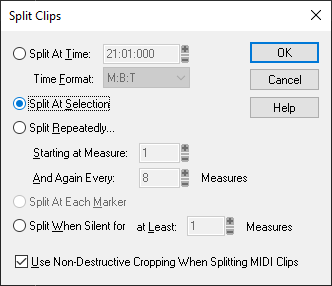-
Posts
7,119 -
Joined
-
Last visited
-
Days Won
39
Everything posted by msmcleod
-
Probably the easiest and quickest way would be to add blank tracks to pad out each group to eight. If you go down the route of using lenses or screensets to hide tracks, it'll get really confusing.
-

How do you drag and drop Take lanes between tracks?
msmcleod replied to craigr68's topic in Cakewalk by BandLab
Just expand the take lanes, and one will be created for you automatically. If you need more, just click on the + sign: -

Emulating Favorite Hardware Patches
msmcleod replied to Sleetah2000's topic in Instruments & Effects
You could probably do it - that is, if you don't mind using 10GB of samples on the one instrument! The number of samples goes up exponentially every time you add a new controller. It'll take a long time to sample, and use up a lot of disk space. -
It'll be fun trying to keep a 4 year old away from it too!! My daughter is nearly 7 now, so she knows not to touch, but at 4 she was still into everything.
-
Don't give up yet... The docking status, position and minimised state of windows is stored with the screenset, so it should be possible to do what you're suggesting. So, you've got the track view spreading over both screens when full screen using the nvidia settings. For the other views, you can un-dock the console and move it so it fills the right monitor, then un-maximise the main track window and move it so it fills the left monitor. This is on one monitor, but you should get the general idea: In the meantime, I'd recommend reporting the now time indicator jumping issue to support@cakewalk.com .
-
I don't think you need to install any apps - the solution was in the standard NVidia control panel: "In the Nvidia Control Panel, Under 3D Settings / Configure Surround , Physics there is an option for "Span displays with surround" which must be enabled. It will require you close all widows to make the final changes. You may also need to restart the PC."
-
@Heinz Hupfer - just found this... the last post might help: https://answers.microsoft.com/en-us/windows/forum/windows_10-start/windows-10-full-screen-across-multiple-monitors/b6c80ffb-7ec8-4249-a08f-ba622e8d1aee
-
Ah, I'd seen that post but didn't put 2 + 2 together. I've not got 2 monitors set up, but if you extend Cakewalk over the two screens, and then press full screen does it extend over both monitors then, or does it revert back to only filling the first one?
-
I think this is a Windows thing - i.e. full screen means full screen on the one monitor. Can't you just resize Cakewalk's window to extend to both monitors? It should remember it the next time you run it.
-
I doubt if any of the things you've listed are the cause of the errors. The most likely cause is either a virus scanner, or cloud storage client accessing those files while you're scanning. Make sure all of Cakewalk's directories and your plugin directories are excluded from virus scans / cloud storage backups. If they try to access files while Cakewalk is trying to use them, you'll run into this sort of issue - or worse a crash. What error are you actually getting?
-
This largely depends on the speed of your internet connection. A full Cakewalk install (minus the addons like Studio Instruments etc, which you probably already have) is just under 600MB. So for me that's around 60-70 seconds to download with an 80Mbps connection (approx 8MB per sec). Once you're up to date, further incremental installers will much smaller in future - usually around 20-30MB.
-
@Harry C. - I had exactly the same problem with Expose. I sent them an email, and they sorted it out for me on their licensing server. They were pretty quick at getting back to me.
-
Acoustica basic edition is a free audio editor that works well with CbB: https://www.pluginboutique.com/product/3-Studio-Tools/48-Audio-Editor/1956-Acoustica-6-Basic-Edition I used @scook 's Tools Editor to add it to my Tools menu. Works a treat.
-
Have you tried running BandLab Assistant as Administrator? Also, what OS are you using?
-

split clip at selection (solved)
msmcleod replied to martsave martin s's topic in Cakewalk by BandLab
"S" will split at the current now time, but won't split a selection (putting a split point either end). Within Key Bindings, if you set the filter to Track View, you can select "Split Clips" (here I've assigned "A" to it): This will bring up the Split dialog, allowing you to select "Split At Selection": This choice is remembered the next time it pops up, so in my example pressing "A" followed by Enter will do it. -
I've found that this helps: 1. Enabling one file per clip in the save dialog, and; 2. Always bouncing to clip(s) individually on the clips BEFORE you normalize It still doesn't completely fix the problems with normalizing more then one clip at once though.
-
-

How do you drag and drop Take lanes between tracks?
msmcleod replied to craigr68's topic in Cakewalk by BandLab
-

split clip at selection (solved)
msmcleod replied to martsave martin s's topic in Cakewalk by BandLab
This is already available.... -
Are you sharing the same instance of DrBeat between both tracks, and sharing the same audio output? If so, that's probably your issue.
-
I can't think of any alternative to unplugging everything and plugging it back in. Before you do that, check your earth connections in any 3 prong plugs. Something could have come loose. Also, check audio cables for dry joints on the earth. I had a nightmare earth loop that went away when I unplugged everything, but came back once everything was back in their rack cases... The mixer & effects were in one rack, and the power amp in another. It turned out the earth loop was through the rack casing itself. Putting some insulating tape around the rim of the case solved it.
-
Everything working fine here on Windows 10 1903 and also on Windows 7.
-
23. Loose (instead of Lose)
-
You could try installing the k-lite codec pack: https://www.codecguide.com/download_kl.htm
-
Another great song John. I love the vocal effect on the last two lines of each verse, and also in the middle 8.







